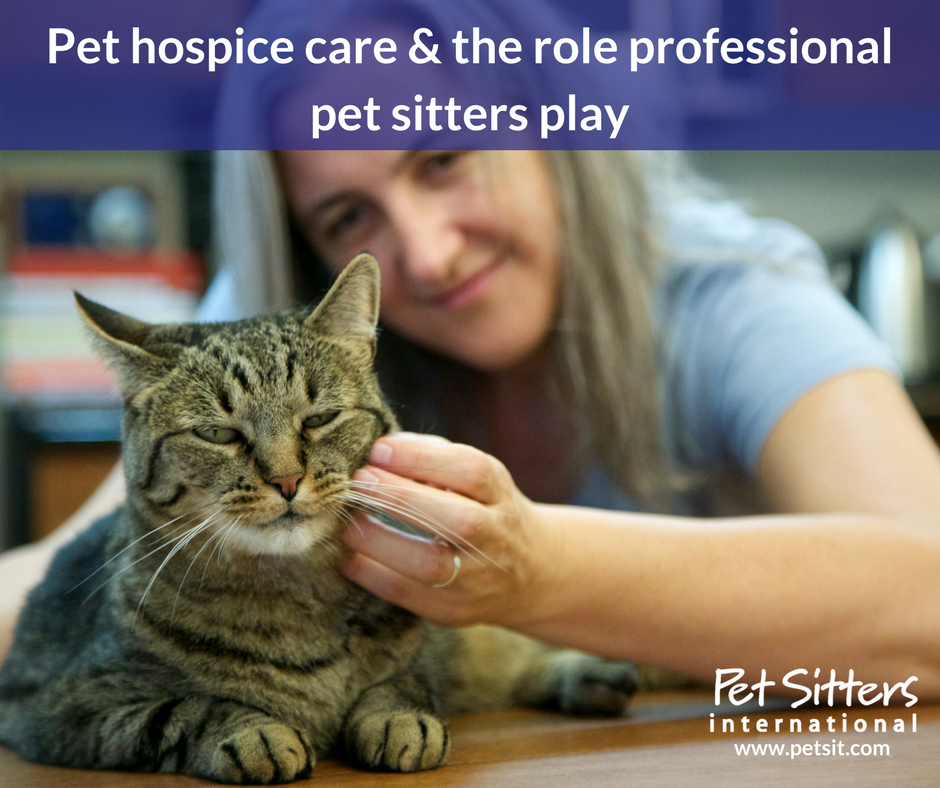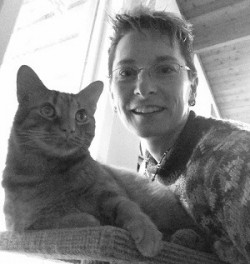Pet hospice care and the role professional pet sitters play

November is Home Care and Hospice Month. While this month is observed to spotlight this growing segment of human healthcare, veterinary hospice care is also a rapidly growing field.
Pet Sitters International interviewed Dr. Mary Gardner, co-founder of Lap of Love Veterinary Hospice, the nation’s largest organization of in-home hospice and euthanasia veterinarians, for its September/October 2015 issue of Pet Sitter’s WORLD magazine to discuss pet hospice care and the role professional pet sitters place in the process.
According to Dr. Gardner, there are three main aspects to veterinary hospice care:
- Educating the humans. As pets age, they can develop many diseases just like humans, including cancer, arthritis and a form of Alzheimer’s. Veterinarians must educate the pet owner about the pet’s disease/s and what symptoms and complications to expect.
- Developing a care plan. Once the pet owner is educated on his or her pet’s disease and its effects, veterinarians have to develop a care plan for the pet. This care plan may include medication, anti-anxiety support, hydrations, changes to the environment to ensure the pet’s comfort and more.
- Understanding the dying process. Another important part of the process is discussing the quality of life and how it can be assessed based on the pet’s disease, the pet’s personality and the family’s beliefs. Many pet owners do not understand the dying process—without the vet’s assistance or with euthanasia; so it’s important they be educated so they are not scared of either method.
Dr. Gardner feels that professional pet sitters have a huge role in the hospice team:
“Owners will not leave town when they have an ailing pet. They must have someone they can trust to care for their pets. Also, many pets in hospice need care during the day while their parents are at work. Most need medications more often, or to be let outside more frequently, or simply to have someone there so they aren’t nervous. Professional pet sitters should learn proper techniques for administering medications orally as well as subcutaneously. This would be a huge benefit to owners who have pets on multiple medications. Owners who have a pet in hospice are more sensitive to their pet’s wellbeing – catering to that is key. Sending texts, pictures, videos, etc., are priceless.”
Read the entire interview with Dr. Gardner here.
A Pet Sitter Shares Her Experiences with Pet Hospice Care…
 PSI Certified Professional Pet Sitters Shannon Huskins, RVT, owner of Paws & Purrs Feline Services in Georgia, shares her experiences with offering feline hospice care:
PSI Certified Professional Pet Sitters Shannon Huskins, RVT, owner of Paws & Purrs Feline Services in Georgia, shares her experiences with offering feline hospice care:
“I began my career in the cat world in 1996 as a vet tech. Later that same year, I decided to pet sit for some clients as a ‘side job’ for extra income and in 1997 I started my own pet-sitting business. Within a year we were caring mainly for cats! By 2005, I had become a Registered Veterinary Technician, and our cat-sitting clientele had morphed into 50 percent healthy kitties and 50 percent geriatric / sick. From there our hospice care became a main focus and that is where our real experiences with senior kitties began. I continued my dual career as both cat sitter and lead veterinary technician working for feline only hospitals until this summer when I officially retired from the veterinary world to focus all of my attention to Paws & Purrs Feline Services.”
“I was lucky in that I had the good fortune to work with amazing cat vets my entire career and really learn, not just medical applications of hospice care, but also how to utilize those skills in a client's home when their feline is ill or struggling with terminal disease. I think most pet sitters rely on their personal cat experiences with their own sick kitties and, of course, we all take a ‘learn as you go’ type of philosophy.
“My recommendation for any pet sitter who does not feel comfortable caring for geriatric cats is to partner with a local feline veterinarian and offer to volunteer on weekends or ‘shadow’ the staff technicians to learn more about senior cats, their needs, how to spot signs of distress in the home and how best to handle those cats. There's nothing better than hands-on experience with trained professionals! I also recommend volunteering for local cat shelters, especially in the geriatric ward. Spend time just watching (even videoing) their mannerisms, how they walk, and how they interact with other cats and staff.
“I use my initial phone consultation with a potential client to discover what illness the cat has been diagnosed with and/or is being treated for and make notes as we talk. Then at the in-home meet and greet, I will watch the senior cat interact with me, the pet patent and any other animals sharing the house. I teach owners and my staff sitters that any change in that senior cat is important and always worth mentioning to the pet parent and the family veterinarian.
“Things that I typically look for include:
- Any discharge (nose, eyes, rectum, etc.)
- Appetite / water consumption (as these changes can certainly be an indicator of diabetes, kidney disease, or thyroid disease)
- Coat condition (is the coat silky, glossy or dull / clumpy)
- Changes in weight
- Body condition (is the kitty bony, overweight, losing muscle mass, too thin in hips?)
- Brightness in eyes
- Signs of limping / lameness (most senior cats deal with some amount of arthritis which can be very painful & debilitating)
- Level of alertness
- Changes in attitude towards family or sitter
- Changes in litterbox output / changes in stool
“My rule of thumb: if you think something is different or "off" about the senior cat, do not wait! Call the client to discuss the symptoms ASAP and potentially seek medical advice/care. If a cat stops eating for even a short period of time, the results can be devastating; so, with cats, time is always of the essence!
“I have seen many occasions where one cat in the home will respond better to one of my staff sitters over me. Don't be offended! Cats are like people - they don't like everyone they meet. With cats (especially senior cats needing daily medications) it's imperative to pair the right sitter for job. If you don't feel like you are a perfect match for the kitty and its needs, then don't hesitate to tell that to the pet parent and help them find a suitable alternative. I have partnerships with other pet sitters all across Atlanta for just that reason.
“Hospice care is not for every pet sitter. Know your limitations. But don't be afraid to learn. Cats are amazingly complicated, but at the same time equally rewarding!”
To learn more about the role pet sitters can play in pet hospice care, read Dr. Gardner’s interview in the September/October 2015 issue of Pet Sitter’s WORLD magazine. To learn more about Dr. Gardner and Lap of Love Veterinary Hospice, visit their website.
As a professional pet sitter, what role have you played in hospice care for your clients’ pets?
Share your stories in the comments below.







Comments
Karen Naismith
Sarah willoughby